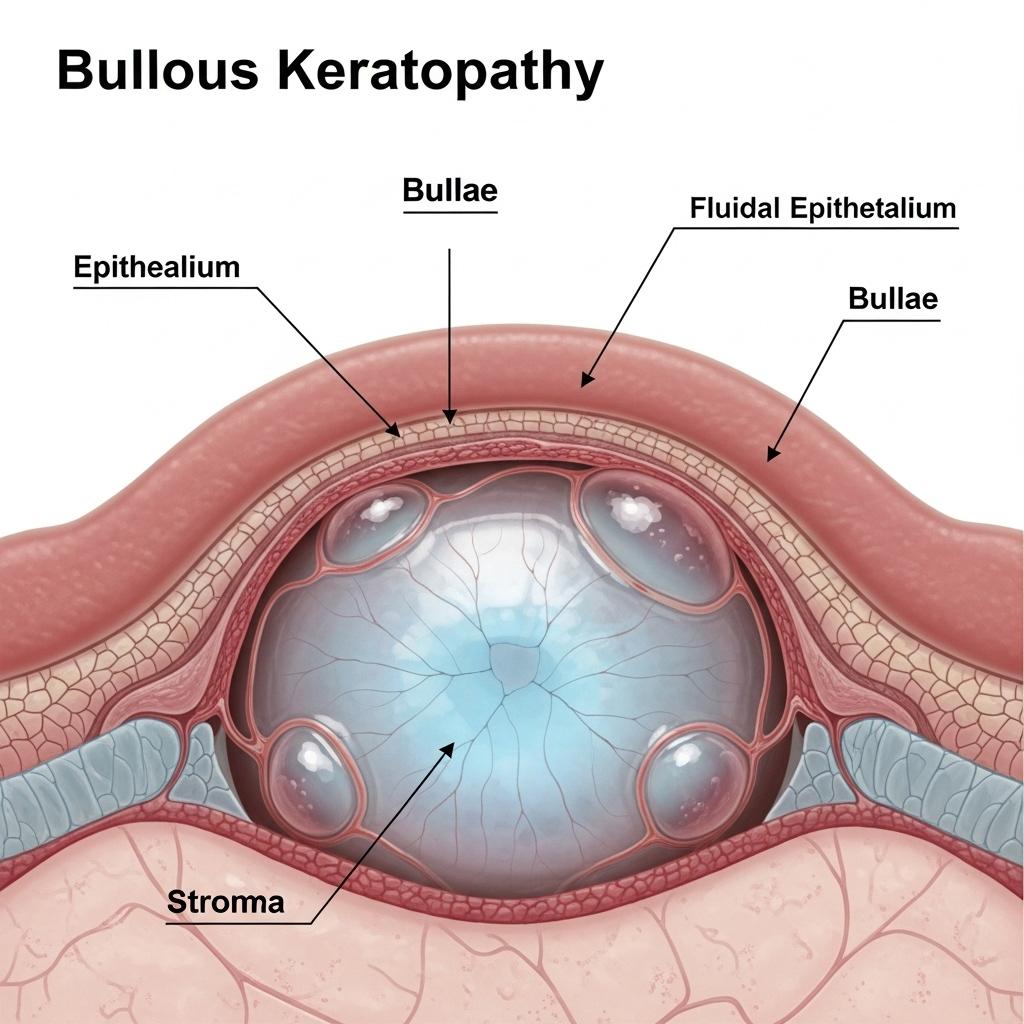Corneal Complications Post-Cataract Surgery: A Focus on Bullous Keratopathy

Bullous Keratopathy (BK) is a painful and vision-impairing condition resulting from corneal endothelial dysfunction, leading to fluid accumulation in the cornea and the formation of epithelial bullae. Most commonly seen after intraocular surgeries, particularly cataract extraction, BK remains a significant complication in ophthalmology. Timely diagnosis and evolving treatment strategies can help preserve vision and patient quality of life.
Request a sample copy of the CI report at: https://www.datamintelligence.com/strategic-insights/ci/bullous-keratopathy-bk
Pathophysiology: Endothelial Cell Failure
The corneal endothelium maintains corneal deturgescence by regulating fluid transport between the aqueous humor and the corneal stroma.
In BK:
* Loss or damage to endothelial cells leads to fluid accumulation in the cornea.
* Hydropic swelling results in stromal thickening and the formation of painful, fluid-filled blisters (bullae).
* Over time, chronic edema disrupts visual acuity and leads to subepithelial fibrosis or scarring.
Causes and Risk Factors
BK is typically secondary to conditions that compromise the corneal endothelium. Common causes include:
* Post-surgical trauma, especially following cataract or glaucoma surgery
* Fuchs endothelial corneal dystrophy
* Chronic intraocular inflammation
* Prolonged intraocular pressure elevation
* Anterior chamber intraocular lens placement
* Age-related decline in endothelial density can exacerbate susceptibility, particularly in older adults undergoing ocular procedures.
Symptoms and Diagnosis
* Bullous Keratopathy often presents with:
* Blurred or decreased vision
* Photophobia
* Foreign body sensation
* Ocular pain, especially with ruptured epithelial bullae
Diagnosis is confirmed through slit-lamp examination, specular microscopy (to assess endothelial cell count and morphology), and pachymetry (measuring corneal thickness).
Current Treatment Strategies
Management depends on disease severity and patient-specific factors:
Medical Therapy (Symptom Relief):
* Hypertonic saline drops or ointment to reduce corneal edema
* Bandage contact lenses for epithelial protection and pain relief
* Topical anti-inflammatory agents to manage secondary inflammation
* Cycloplegics to reduce photophobia and discomfort
While these do not restore endothelial function, they help improve patient comfort and temporarily stabilize symptoms.
Surgical Management:
In cases where vision is significantly impaired or pain persists, surgical options become necessary:
1. Endothelial Keratoplasty (EK): Descemet Stripping Endothelial Keratoplasty (DSEK) or Descemet Membrane Endothelial Keratoplasty (DMEK) selectively replaces the damaged endothelium.
2. DMEK, offering faster recovery and better visual outcomes, is increasingly preferred but requires higher surgical precision.
3. Penetrating Keratoplasty (PK): A full-thickness corneal transplant is reserved for cases with stromal scarring or multiple failed EKs.
4. Anterior Stromal Puncture (ASP): A palliative procedure to create adhesion between epithelium and stroma, reducing bullae formation.
Innovations and Future Therapies
The treatment of BK is evolving with new approaches:
1. Cell-based therapies, including cultured corneal endothelial cell injection combined with ROCK inhibitors, aim to regenerate the endothelium.
2. Artificial corneas (keratoprosthesis) may be explored in high-risk graft failure patients.
Advances in gene therapy and regenerative medicine offer potential for restoring native endothelial function without transplantation.
Request a CI consultation at: https://www.datamintelligence.com/strategic-insights/ci/bullous-keratopathy-bk
Real-World Challenges
Access to endothelial keratoplasty remains limited in many regions due to:
1. Shortage of donor corneas
2. Lack of trained corneal surgeons
3. High costs of surgery and post-operative care
4. Improving awareness, expanding eye banking systems, and fostering international collaborations are essential to address global disparities in care.
About DataM Intelligence
DataM Intelligence 4Market Research LLP delivers real-time competitive intelligence across autoimmune, immunologic, and rare disease spaces. Our insights span clinical pipelines, regulatory benchmarks, and commercialization strategies for stakeholders in global life sciences.
🔗 Visit: www.datamintelligence.com
- Art
- Causes
- Crafts
- Dance
- Drinks
- Film
- Fitness
- Food
- Juegos
- Gardening
- Health
- Home
- Literature
- Music
- Networking
- Other
- Party
- Religion
- Shopping
- Sports
- Theater
- Wellness


